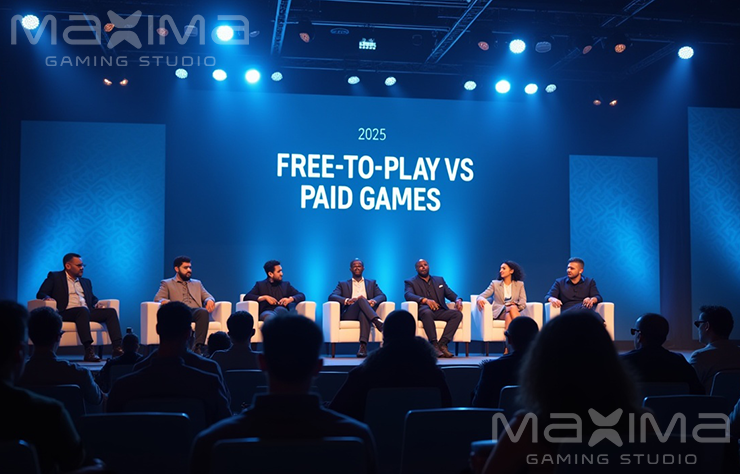 January 11, 2023
January 11, 2023
The gaming industry is constantly evolving, and one of the most critical decisions developers face today is choosing the right monetization model for their games. With the explosive growth of mobile gaming, digital distribution platforms, and emerging technologies like cloud gaming and AI-driven content, understanding the advantages and challenges of Free-to-Play (F2P) and Paid Games models is essential for any developer aiming to succeed in 2025.
This article dives deep into both models, market trends, player psychology, and what the future might hold, helping developers make informed choices.
What is Free-to-Play (F2P)?
Free-to-Play games allow users to download and play without any upfront cost. The monetization comes primarily from in-app purchases (IAP), advertisements, subscriptions, or a combination of these. Popular examples include titles like PUBG Mobile, Clash of Clans, and Genshin Impact.
Monetization Strategies in F2P
- In-App Purchases: Players buy virtual goods, skins, currency, or boosts.
- Advertisements: Display ads, rewarded videos, interstitials.
- Subscriptions: Monthly passes offering exclusive content or bonuses.
- Season Passes & Battle Passes: Unlock premium content over time with a single purchase.
Pros of F2P
- Large User Base: Removing upfront cost lowers barriers, attracting millions.
- Ongoing Revenue: Continuous income from engaged players.
- Easy Updates: Developers can introduce new content regularly.
- Viral Potential: Social sharing and multiplayer features boost growth.
Cons of F2P
- High Development & Maintenance Cost: Needs constant updates and support.
- Monetization Balance: Must avoid pay-to-win traps that alienate players.
- Player Drop-off: Many users churn quickly without spending.
- Ad Fatigue: Overuse of ads can reduce retention.
What is the Paid Games Model?
Paid games require users to pay upfront to download or access the full game experience. This traditional model was dominant during the early days of console and PC gaming.
Characteristics of Paid Games
- One-Time Purchase: Fixed price for full content access.
- Premium Experience: Usually no ads or pay-to-win elements.
- Limited Updates: Fewer content updates compared to F2P.
- Physical or Digital Sales: Through platforms like Steam, Epic Store, App Store.
Pros of Paid Games
- Guaranteed Revenue: Developers get paid upfront, reducing financial risk.
- Player Trust: Players expect full content without constant monetization pushes.
- Creative Freedom: Less pressure for monetization-driven design.
- Community Loyalty: Dedicated players who support developers.
Cons of Paid Games
- Limited Audience: High entry cost can deter casual players.
- Piracy Risk: Paid games are more vulnerable to illegal copies.
- Lower Long-Term Revenue: Once sold, no ongoing income from players.
- Marketing Challenges: Harder to convince players to buy upfront without demos.
Market Trends in 2025
The global gaming market in 2025 continues to be dominated by Free-to-Play, especially on mobile platforms. According to industry reports:
- Over 75% of mobile game revenue is generated by F2P models.
- The paid game segment remains stronger on PC and consoles but is gradually declining in market share.
- In India, the surge in affordable smartphones and data has accelerated F2P adoption, making it the dominant model.
- User demographics show casual gamers prefer F2P, while hardcore gamers still invest in premium titles.
Player Psychology & Monetization
Monetization strategy directly influences how players interact with a game:
- F2P games rely on frequent engagement and psychological hooks like rewards, limited-time events, and social competition to drive spending. This can boost retention but risks player burnout.
- Paid games focus more on delivering a complete, polished experience that players enjoy over long periods without monetization pressure. This builds trust and satisfaction but limits viral growth.
Understanding your target audience’s preferences is crucial.
Case Studies of Successful F2P and Paid Games in 2025
- F2P Example: Genshin Impact continues to dominate mobile and PC with a gacha-based F2P model that generates billions annually by blending rich content and optional purchases.
- Paid Example: Elden Ring (console/PC) demonstrates how a premium, story-driven game with one-time purchase can capture critical acclaim and long-term sales.
Hybrid Models: The Best of Both Worlds?
Many developers adopt hybrid monetization models in 2025:
- Free demo + paid full game: Allow players to try before buying.
- F2P with premium season passes: Basic gameplay is free, but advanced content requires purchase.
- Cosmetic-only microtransactions: Keeps gameplay fair while monetizing customization.
This approach maximizes user acquisition and revenue potential.
Challenges and Ethical Considerations
F2P games often face criticism for “pay-to-win” elements and potential addiction. Developers must balance monetization with fairness. Conversely, paid games risk alienating players with high prices or lack of ongoing content.
Which Model Wins in 2025?
While Free-to-Play leads in sheer revenue and user base—especially on mobile—paid games hold strong niches on PC and consoles with loyal audiences. Hybrid models are gaining traction, blending accessibility with monetization.
For developers, the best choice depends on:
- Target platform and audience
- Game genre and design
- Long-term vision and resources
Conclusion
In 2025, there is no one-size-fits-all winner between Free-to-Play and Paid Games. Instead, understanding the strengths, challenges, and player expectations of each model is essential. Smart developers leverage hybrid strategies and player-centric design to thrive in the evolving gaming landscape.
Whether you’re an indie developer or part of a big studio, choosing the right monetization model can define your game’s success and longevity.


